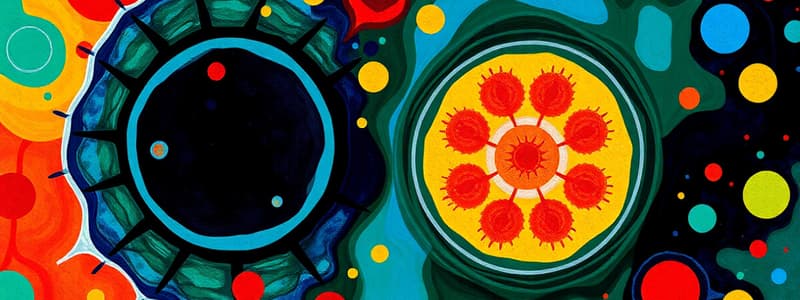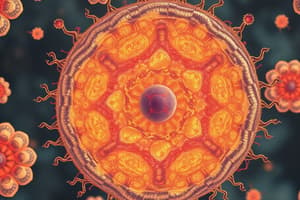Podcast
Questions and Answers
What do eukaryotic cells contain that prokaryotic cells lack?
What do eukaryotic cells contain that prokaryotic cells lack?
- Ribosomes
- Cytoplasm
- Genetic material
- Membrane-bound organelles (correct)
Which organelle is primarily responsible for energy production in eukaryotic cells?
Which organelle is primarily responsible for energy production in eukaryotic cells?
- Nucleus
- Endoplasmic reticulum
- Lysosomes
- Mitochondria (correct)
What is the primary function of the cell membrane?
What is the primary function of the cell membrane?
- Energy production
- Regulating entry and exit of substances (correct)
- Synthesis of proteins
- Storage of genetic material
Which process is a driving mechanism of evolution that involves changes in traits over generations?
Which process is a driving mechanism of evolution that involves changes in traits over generations?
What type of speciation occurs due to geographic separation?
What type of speciation occurs due to geographic separation?
Which evidence for evolution specifically suggests common ancestry through structural similarities?
Which evidence for evolution specifically suggests common ancestry through structural similarities?
What is a cladogram used for in phylogenetics?
What is a cladogram used for in phylogenetics?
What component of natural selection involves differences in traits among individuals?
What component of natural selection involves differences in traits among individuals?
What is the primary function of carbohydrates in cells?
What is the primary function of carbohydrates in cells?
What characteristic distinguishes eukaryotic cells from prokaryotic cells?
What characteristic distinguishes eukaryotic cells from prokaryotic cells?
Which process occurs in mitochondria and produces ATP?
Which process occurs in mitochondria and produces ATP?
What role do lysosomes play in the cell?
What role do lysosomes play in the cell?
Which phase represents the conversion of mRNA into a polypeptide chain?
Which phase represents the conversion of mRNA into a polypeptide chain?
What is an essential characteristic of the phospholipid bilayer in the cell membrane?
What is an essential characteristic of the phospholipid bilayer in the cell membrane?
Which component is involved in the Calvin cycle during photosynthesis?
Which component is involved in the Calvin cycle during photosynthesis?
What forms the backbone of proteins?
What forms the backbone of proteins?
Flashcards are hidden until you start studying
Study Notes
Cell Structure
-
Basic Units of Life
- Cells are the fundamental building blocks of all living organisms.
- Two main types of cells: prokaryotic (without nucleus) and eukaryotic (with nucleus).
-
Prokaryotic Cells
- Lack membrane-bound organelles.
- Example: Bacteria and Archaea.
- Structure includes:
- Plasma membrane
- Cytoplasm
- Ribosomes
- Genetic material (circular DNA)
-
Eukaryotic Cells
- Contain membrane-bound organelles.
- Examples: Animal cells, plant cells, fungi, and protists.
- Key organelles include:
- Nucleus: houses genetic material.
- Mitochondria: energy production (ATP).
- Endoplasmic reticulum: synthesis of proteins and lipids.
- Golgi apparatus: modification and packaging of proteins.
- Lysosomes: digestion and waste removal.
- Cell wall (in plants): structural support and protection.
-
Cell Membrane
- Composed of a phospholipid bilayer with embedded proteins.
- Functions: regulates entry and exit of substances, communication, and cell signaling.
-
Cytoskeleton
- Network of protein filaments and tubules.
- Provides structural support, aids in cell movement, and organizes organelles.
Evolutionary Biology
-
Basic Principles of Evolution
- Evolution is the change in the heritable characteristics of biological populations over successive generations.
- Driven by mechanisms such as natural selection, mutation, gene flow, and genetic drift.
-
Evidence for Evolution
- Fossil records: show transitional forms and changes over time.
- Comparative anatomy: similarities in structure among different species indicate common ancestry (homologous structures).
- Molecular biology: genetic similarities among species provide insights into evolutionary relationships.
-
Evolutionary Developmental Biology (Evo-Devo)
- Examines the relationship between ontogeny (development) and phylogeny (evolution).
- Focuses on how changes in developmental processes lead to evolutionary changes.
Cell Structure
-
Cells are the basic units of life, classified as prokaryotic or eukaryotic.
-
Prokaryotic Cells
- Do not have membrane-bound organelles.
- Examples include bacteria and archaea.
- Composed of a plasma membrane, cytoplasm, ribosomes, and circular DNA as genetic material.
-
Eukaryotic Cells
- Feature membrane-bound organelles.
- Include animal cells, plant cells, fungi, and protists.
- Key organelles consist of:
- Nucleus, which stores genetic material.
- Mitochondria, responsible for ATP production.
- Endoplasmic reticulum for protein and lipid synthesis.
- Golgi apparatus for protein modification and packaging.
- Lysosomes for digestion and waste removal.
- Cell wall (found in plants) for structural support and protection.
-
Cell Membrane
- Made up of a phospholipid bilayer with embedded proteins.
- Functions include regulating substance entry and exit, communication, and signaling.
-
Cytoskeleton
- A network of protein filaments and tubules that provides structural support, aids in movement, and organizes organelles.
Evolutionary Biology
-
Evolution entails changes in heritable traits of biological populations across generations.
-
Natural Selection
- Mechanism by which advantageous traits that improve fitness lead to better survival and reproduction.
- Key factors involve:
- Variation in traits among individuals.
- Inheritance of traits from parents.
- Differential survival and reproductive success based on these traits.
-
Speciation
- The formation of new species through evolutionary processes.
- Types include:
- Allopatric speciation, occurring due to geographic separation.
- Sympatric speciation, arising from reproductive isolation within the same location.
-
Evidence for Evolution
- Fossil records indicate transitional forms and evolutionary changes.
- Comparative anatomy highlights homologous structures that suggest common ancestry.
- Molecular biology examines genetic similarities to elucidate evolutionary connections.
-
Phylogenetics
- Investigates evolutionary relationships among biological entities using cladograms and phylogenetic trees to illustrate these pathways.
-
Evolutionary Developmental Biology (Evo-Devo)
- Explores the connection between developmental processes (ontogeny) and evolutionary changes (phylogeny).
- Focuses on how developmental changes can lead to evolutionary shifts.
Chemistry and Structure of the Cell
-
Biomolecules include four main categories:
- Carbohydrates: Serve as energy sources and structural components; examples include sugars and starches.
- Proteins: Composed of amino acids; essential for enzymes, structural roles, and transport functions.
- Lipids: Consist of fatty acids and glycerol; crucial for energy storage and forming cell membranes.
- Nucleic Acids: DNA and RNA function in storing and transferring genetic information.
-
Cell Membrane:
- Comprised of a phospholipid bilayer with embedded proteins.
- Functions as a selectively permeable barrier, facilitating communication and transport of substances.
-
Water:
- Acts as a solvent for biochemical reactions, regulates temperature, and is involved in metabolic processes.
Cellular Structure
-
Prokaryotic Cells:
- Do not possess a nucleus; DNA is circular and found in the nucleoid region.
- Contain ribosomes, a cell wall made of peptidoglycan, and a plasma membrane, with some having flagella for movement.
-
Eukaryotic Cells:
- Have a nucleus which contains linear DNA organized into chromosomes.
- Key organelles include:
- Nucleus: Stores DNA; contains nucleolus for ribosome synthesis.
- Mitochondria: Known as the powerhouse of the cell; site of ATP production through cellular respiration.
- Endoplasmic Reticulum (ER):
- Rough ER: Studded with ribosomes, important for protein synthesis.
- Smooth ER: Lacks ribosomes, involved in lipid synthesis.
- Golgi Apparatus: Modifies, sorts, and packages proteins and lipids for transport.
- Lysosomes: Contain digestive enzymes to process waste materials.
- Chloroplasts: Found in plant cells, responsible for photosynthesis.
Basic Cellular Processes
-
Cellular Respiration:
- Converts glucose and oxygen into ATP, carbon dioxide, and water.
- Comprises three main stages: Glycolysis, Krebs Cycle, and Electron Transport Chain.
-
Photosynthesis:
- Transforms light energy into chemical energy (glucose) using carbon dioxide and water.
- Takes place in chloroplasts and includes light-dependent reactions and the Calvin cycle (light-independent reactions).
-
Cell Division:
- Mitosis: Process for somatic cell division, resulting in two identical daughter cells for growth and repair.
- Meiosis: Generates four genetically diverse daughter cells for gamete formation.
-
Protein Synthesis:
- Transcription: Process of synthesizing mRNA from DNA in the nucleus.
- Translation: Converting mRNA into a polypeptide chain at ribosomes.
-
Cell Signaling:
- Involves communication between cells using signaling molecules (e.g., hormones, neurotransmitters).
- Consists of reception, transduction, and response mechanisms to relay information.
Studying That Suits You
Use AI to generate personalized quizzes and flashcards to suit your learning preferences.




